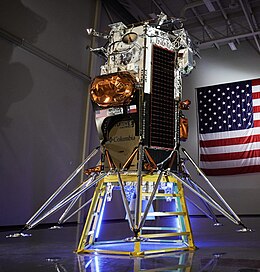
Back أي إم-1 Arabic IM-1 Azerbaijani Intuitive Machines Mission 1 Czech IM-1 German IM-1 Spanish IM-1 Finnish Intuitive Machines One French IM-1 Irish IM-1 HE IM-1 ID
 Nova-C Class IM-1 Odysseus in preparation for launch | |
| Names | IM-1 TO2-IM[1] CLPS-2[2] |
|---|---|
| Mission type | Lunar landing |
| Operator | Intuitive Machines |
| COSPAR ID | 2024-030A |
| SATCAT no. | 58963 |
| Mission duration | 14 days[3] |
| Spacecraft properties | |
| Spacecraft | Odysseus |
| Spacecraft type | Nova-C |
| Manufacturer | Intuitive Machines |
| Launch mass | 1,900 kilograms (4,200 lb) |
| Start of mission | |
| Launch date | February 15, 2024, 06:05:00 UTC |
| Rocket | Falcon 9 Block 5 (B1060.18) |
| Launch site | Kennedy LC-39A |
| End of mission | |
| Declared | March 23, 2024[4] |
| Last contact | February 29, 2024[3] |
| Lunar lander | |
| Landing date | February 22, 2024, 23:23:00 UTC |
| Landing site | Malapert A 80°08′S 1°26′E / 80.13°S 1.44°E[5] |
 IM-1 mission insignia Motto: ADTIGO PLANITIA LUNAE (I touch the plains of the Moon) (Stick The Landing)[6] | |
IM-1 was a lunar mission that was carried out in February 2024 jointly by a partnership between the NASA CLPS program and Intuitive Machines (IM), using an Nova-C lunar lander. IM named their lunar lander as its Odysseus lander. The Odysseus lander was the first commercial lunar lander to have successfully soft-landed on the Moon.[7][8]
After contact with the lunar surface the lander tipped to an unplanned 30 degree angle. All instrument payloads remained functional and the mission was deemed successful.[9] Intuitive Machines initially stated there was a possibility the lander could wake up in about three weeks when the sun comes out,[10] but on March 23 the company announced its conclusion that the lander's electronics had not survived the lunar night, and the mission was declared over.[11][12]
Odysseus's "rough" soft Moon landing is the first soft lunar landing of any kind for an American-made spacecraft since Apollo 17 in 1972. It is the first soft lunar landing by a private company.[13][14] It is the first liquid methane and liquid oxygen (methalox)-powered spacecraft to fire beyond low-earth orbit, and it is also the first methalox spacecraft to land on an off-world celestial body.[15] Odysseus carried six payloads developed by NASA in addition to others from commercial and educational customers.
- ^ Cite error: The named reference
nasa1was invoked but never defined (see the help page). - ^ Cite error: The named reference
clps1was invoked but never defined (see the help page). - ^ a b Cite error: The named reference
reuters1was invoked but never defined (see the help page). - ^ Cite error: The named reference
im-3-23was invoked but never defined (see the help page). - ^ Cite error: The named reference
coordswas invoked but never defined (see the help page). - ^ Cite error: The named reference
mottowas invoked but never defined (see the help page). - ^ Cite error: The named reference
NYT-20240226was invoked but never defined (see the help page). - ^ Cite error: The named reference
NYT-20240222was invoked but never defined (see the help page). - ^ Cite error: The named reference
snews2was invoked but never defined (see the help page). - ^ Cite error: The named reference
barronswas invoked but never defined (see the help page). - ^ Cite error: The named reference
space.com6was invoked but never defined (see the help page). - ^ Cite error: The named reference
phys.org1was invoked but never defined (see the help page). - ^ Cite error: The named reference
ap-plwas invoked but never defined (see the help page). - ^ Cite error: The named reference
nxsf-im1was invoked but never defined (see the help page). - ^ Cite error: The named reference
im1was invoked but never defined (see the help page).